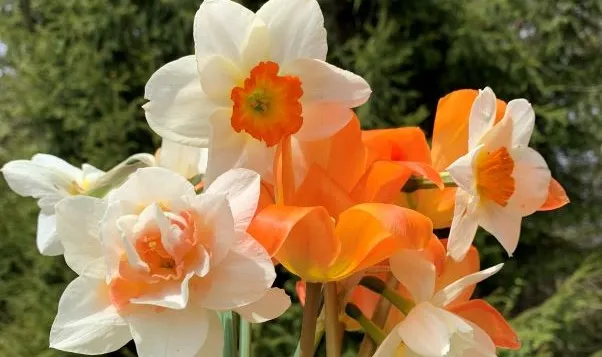The daffodil, with its radiant yellow petals and bright appearance, holds an extraordinary spot in hearts all over the planet. This beguiling bloom has propelled writers, groundskeepers, and specialists for a long time. Its excellence and imagery make it a dearest sprout, whether in gardens or as a piece of social customs.
We will investigate why the daffodil is so esteemed worldwide, from its imagery to its adaptability in different environments. We should jump into the spellbinding universe of this notorious blossom.
Introduction to the Daffodil
The daffodil, logically known as Narcissus, is a spring-blossoming bloom that has a place with the Amaryllidaceae family. It is local to Europe and North Africa however has spread overall because of its notoriety.
Portrayed by its trumpet-molded crown and dynamic petals, the daffodil is an indication of reestablishment and trust, as it frequently blossoms after the cruel cold weather months.
The History of the Daffodil
Daffodils have been developed for millennia. Old civic establishments, like the Greeks and Romans, respected their magnificence and, surprisingly, credited restorative properties to them. The bloom’s name, Narcissus, comes from Greek folklore. As per legend, a young fellow named Narcissus experienced passionate feelings for his appearance and changed into the daffodil as an image of vanity and confidence.
During the Renaissance, daffodils turned into a famous theme in workmanship and verse, representing virtue and resurrection. Today, they stay a dearest bloom around the world.
Symbolism and Cultural Significance
The daffodil conveys profound representative implications across various societies:
- Recharging and Resurrection: As a spring bloom, the daffodil addresses fresh starts and trust.
- Best of Luck: In Chinese culture, daffodils are related to favorable luck and thriving. They are much of the time gifted during the Lunar New Year.
- Empathy and Care: In numerous nations, the daffodil is an image of help for malignant growth mindfulness crusades.
Varieties of Daffodils
There are north of 50 types of daffodils and a huge number of half-breeds. A few well-known assortments include:
- Trumpet Daffodils: Known for their huge trumpets, like the exemplary Ruler Alfred.
- Twofold Daffodils: Including various layers of petals, adding additional appeal.
- Scaled-down Daffodils: Ideal for little gardens or pots.
- Poeticus Daffodils: Known for their white petals and little, red-rimmed crowns.
Every assortment has novel elements, making daffodils flexible for various planting needs.

Why Daffodils Are Popular in Gardens
Simple to Develop
Daffodils are one of the most fledgling accommodating blossoms. They flourish in different soil types and require negligible upkeep.
Versatility
Daffodils are solid and can endure cold temperatures. Their bulbs store supplements, permitting them to sprout for a large number of years.
Bother Obstruction
Not at all like many blossoms, daffodils are deer- and bunny-safe, making them ideal for gardens inclined to natural life visits.
How to Grow and Care for Daffodils
Developing daffodils is basic if you follow these means:
Planting
When to Plant: Plant bulbs in the fall before the main ice.
Area: Pick a spot with very much depleted soil and full sun or fractional shade.
Profundity: Plant bulbs 4-6 inches down and space them around 3 inches separated.
Watering
Water the bulbs after planting. During the developing season, water them reasonably, guaranteeing the dirt doesn’t become waterlogged.
Post-Sprout Care
After the blossoms blur, permit the foliage to pass on back normally. This interaction assists the bulb with putting away energy for the following season.
Daffodils in Art and Literature
Daffodils have enlivened incalculable things of beauty and writing. Perhaps the most popular reference comes from William Wordsworth’s sonnet I Meandered Forlorn as a Cloud:
“I gazed—and gazed—but little thought
What wealth the show to me had brought.”
This immortal sonnet catches the delight and ponders daffodils summon. Also, craftsmen like Van Gogh and Monet have integrated daffodils into their artworks, praising their magnificence.
Celebrations Featuring Daffodils
Daffodils are a huge piece of different celebrations and festivities:
- St. David’s Day: In Ridges, daffodils are worn on Spring first to respect the country’s supporter holy person.
- Spring Celebrations: Daffodils are a typical component in spring marches and nursery shows around the world.
- Disease Mindfulness Missions: Numerous associations use daffodils as images of trust and strength.
Environmental Benefits of Daffodils
Daffodils are lovely as well as helpful for the climate:
- Soil Adjustment: Their foundations assist with forestalling soil disintegration.
- Pollinator Backing: They draw in honey bees and different pollinators, adding to the environment’s well-being.
- Air Refinement: Like all plants, daffodils ingest carbon dioxide and deliver oxygen, further developing air quality.
Conclusion
The daffodil’s energetic appeal and profound imagery deserve it an exceptional spot in nurseries and hearts around the world. From its authentic roots to its advanced importance, this blossom proceeds to rouse and inspire.
Whether you’re a planting fan or just value nature’s magnificence, the daffodil is an immortal indication of life’s perseverance through restoration. Establishing these wonderful sprouts improves your environmental elements as well as gives a bit of pleasure and desire to your life.
FAQs
Q1: Might daffodils at any point develop inside?
Indeed, you can develop daffodils inside pots. Guarantee they get sufficient daylight and water.
Q2: How long do daffodils blossom?
Daffodils commonly blossom for 4 a month and a half in the spring.
Q3: Are daffodils poisonous?
Indeed, daffodils contain intensities that are poisonous to people and pets whenever ingested. Handle them with care.
Q4: Could daffodils at any point duplicate?
Indeed, daffodils increase through bulb division. Over the long run, they can frame groups that you can isolate and replant.
Q5: What do daffodils represent?
Daffodils represent recharging, trust, and favorable luck in different societies.
Explore more: hsnimewhimsy





